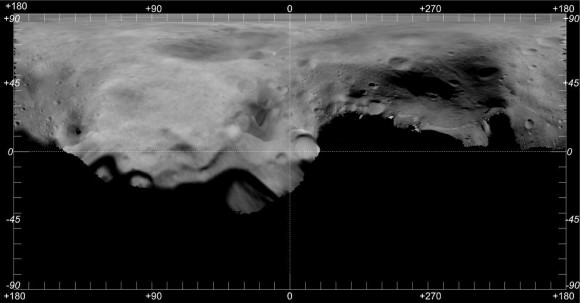
Several images have been combined into a map of the asteroid. This image represents the total area viewed by the spacecraft during the flyby, which amounted to more than 50% of Lutetia’s surface. Credits: ESA 2011 MPS for OSIRIS Team MPS/UPD/LAM/IAA/RSSD/INTA/UPM/DASP/IDA
Way out in space, 282 million miles from home, the intrepid ESA Rosetta spacecraft is still busy, but had time to send us an unprecedented view of ancient asteroid Lutetia. On July 10, 2010, Rosetta flew past Lutetia and the results of the imaging revealed surface features which point to an astonishing history. This particular asteroid might not have a “heart of gold”, but it may very well have – or had – a molten interior.
Buzzing by at a speed of 54 000 km/hr and a closest distance of 3170 km, Rosetta took a series of high resolution images and returned them to an international team of researchers from France, Germany, the Netherlands and the United States. By closely examining the craters, cracks and surface, the team was able to determine that Lutetia survived a multitude of impacts – yet retained much of its original structure.
Lutetia fly-by from Science News on Vimeo.
Benjamin Weiss, an associate professor of planetary sciences in MIT’s Department of Earth, Atmospheric and Planetary Sciences, reports Lutetia may have a molten core and this finding shows a “hidden diversity” for known structures within the greater asteroid belt.
“There might be many bodies that have cores and interesting interiors that we never noticed, because they’re covered by unmelted surfaces,” says Weiss, who is a co-author on both Science papers and lead author for the paper in PSS. “The asteroid belt may be more interesting than it seems on the surface.”
Although the encounter was brief, images from the OSIRIS camera revealed some surface features which are believed to be up to 3.6 billion years old – while others appear to be 50-80 million. These ages can be estimated through impact events and the amount and distribution of ejecta. Some of the areas on Lutetia are heavily cratered, implying greater age, while others appear to be landslide events perhaps caused by nearby fractures. While most asteroids are small, light, and have smooth surfaces – Lutetia is different. It appears to be dense, yet relatively porous… a finding that points toward a “dense metallic core, with a once melted interior underneath its fractured crust.”
“We don’t think Lutetia was born looking like this,” says Holger Sierks, of the Max-Planck-Institut für Sonnensystemforschung, Lindau, Germany. “It was probably round when it formed.”
You’ve got to hand it to Rosetta. By being able to study these images, the many teams of scientists now have evidence for a theory developed last year by Weiss, Elkins-Tanton and MIT’s Maria Zuber. By studying chondrite meteorites, they’ve speculated these strongly magnetized samples most likely occurred in an asteroid with a melted, metallic core. If this theory proves to be correct, the Lutetia simply managed to dodge the proverbial bullets and developed with a molten interior.
“The planets … don’t retain a record of these early differentiation processes,” Weiss says. “So this asteroid may be a relic of the first events of melting in a body.”
According to MIT news, Erik Asphaug, a professor of planetary science at the University of California at Santa Cruz, studies “hit-and-run” collisions between early planetary bodies. He says the work by Weiss and his colleagues is a solid step toward resolving how certain asteroids like Lutetia may have evolved.
“We’ve had decades of cartoon speculation, and here’s speculation that’s anchored in physical understanding of how the interiors of these bodies would evolve,” says Asphaug, who was not involved in the research. “It’s like getting through the first 100 pages of a novel, and you don’t know where it’s leading, but it feels like the beginnings of a coherent picture.”
Another Rosetta stone?
Original Story Sources: ESA News Release and MIT News Release.
Source: Universe Today
No hay comentarios:
Publicar un comentario